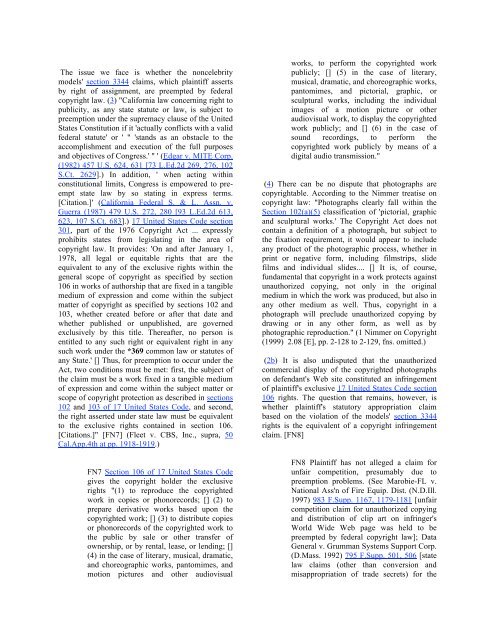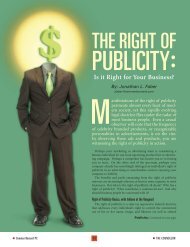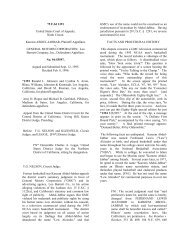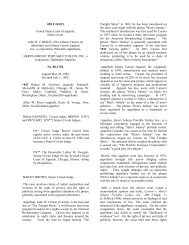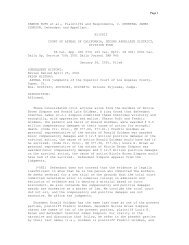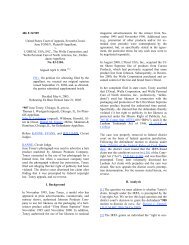KNB ENTERPRISES, Plaintiff and Appellant, v ... - Right Of Publicity
KNB ENTERPRISES, Plaintiff and Appellant, v ... - Right Of Publicity
KNB ENTERPRISES, Plaintiff and Appellant, v ... - Right Of Publicity
You also want an ePaper? Increase the reach of your titles
YUMPU automatically turns print PDFs into web optimized ePapers that Google loves.
The issue we face is whether the noncelebrity<br />
models' section 3344 claims, which plaintiff asserts<br />
by right of assignment, are preempted by federal<br />
copyright law. (3) "California law concerning right to<br />
publicity, as any state statute or law, is subject to<br />
preemption under the supremacy clause of the United<br />
States Constitution if it 'actually conflicts with a valid<br />
federal statute' or ' " 'st<strong>and</strong>s as an obstacle to the<br />
accomplishment <strong>and</strong> execution of the full purposes<br />
<strong>and</strong> objectives of Congress.' " ' (Edgar v. MITE Corp.<br />
(1982) 457 U.S. 624, 631 [73 L.Ed.2d 269, 276, 102<br />
S.Ct. 2629].) In addition, ' when acting within<br />
constitutional limits, Congress is empowered to preempt<br />
state law by so stating in express terms.<br />
[Citation.]' (California Federal S. & L. Assn. v.<br />
Guerra (1987) 479 U.S. 272, 280 [93 L.Ed.2d 613,<br />
623, 107 S.Ct. 683].) 17 United States Code section<br />
301, part of the 1976 Copyright Act ... expressly<br />
prohibits states from legislating in the area of<br />
copyright law. It provides: 'On <strong>and</strong> after January 1,<br />
1978, all legal or equitable rights that are the<br />
equivalent to any of the exclusive rights within the<br />
general scope of copyright as specified by section<br />
106 in works of authorship that are fixed in a tangible<br />
medium of expression <strong>and</strong> come within the subject<br />
matter of copyright as specified by sections 102 <strong>and</strong><br />
103, whether created before or after that date <strong>and</strong><br />
whether published or unpublished, are governed<br />
exclusively by this title. Thereafter, no person is<br />
entitled to any such right or equivalent right in any<br />
such work under the *369 common law or statutes of<br />
any State.' [] Thus, for preemption to occur under the<br />
Act, two conditions must be met: first, the subject of<br />
the claim must be a work fixed in a tangible medium<br />
of expression <strong>and</strong> come within the subject matter or<br />
scope of copyright protection as described in sections<br />
102 <strong>and</strong> 103 of 17 United States Code, <strong>and</strong> second,<br />
the right asserted under state law must be equivalent<br />
to the exclusive rights contained in section 106.<br />
[Citations.]" [FN7] (Fleet v. CBS, Inc., supra, 50<br />
Cal.App.4th at pp. 1918-1919.)<br />
FN7 Section 106 of 17 United States Code<br />
gives the copyright holder the exclusive<br />
rights "(1) to reproduce the copyrighted<br />
work in copies or phonorecords; [] (2) to<br />
prepare derivative works based upon the<br />
copyrighted work; [] (3) to distribute copies<br />
or phonorecords of the copyrighted work to<br />
the public by sale or other transfer of<br />
ownership, or by rental, lease, or lending; []<br />
(4) in the case of literary, musical, dramatic,<br />
<strong>and</strong> choreographic works, pantomimes, <strong>and</strong><br />
motion pictures <strong>and</strong> other audiovisual<br />
works, to perform the copyrighted work<br />
publicly; [] (5) in the case of literary,<br />
musical, dramatic, <strong>and</strong> choreographic works,<br />
pantomimes, <strong>and</strong> pictorial, graphic, or<br />
sculptural works, including the individual<br />
images of a motion picture or other<br />
audiovisual work, to display the copyrighted<br />
work publicly; <strong>and</strong> [] (6) in the case of<br />
sound recordings, to perform the<br />
copyrighted work publicly by means of a<br />
digital audio transmission."<br />
(4) There can be no dispute that photographs are<br />
copyrightable. According to the Nimmer treatise on<br />
copyright law: "Photographs clearly fall within the<br />
Section 102(a)(5) classification of 'pictorial, graphic<br />
<strong>and</strong> sculptural works.' The Copyright Act does not<br />
contain a definition of a photograph, but subject to<br />
the fixation requirement, it would appear to include<br />
any product of the photographic process, whether in<br />
print or negative form, including filmstrips, slide<br />
films <strong>and</strong> individual slides.... [] It is, of course,<br />
fundamental that copyright in a work protects against<br />
unauthorized copying, not only in the original<br />
medium in which the work was produced, but also in<br />
any other medium as well. Thus, copyright in a<br />
photograph will preclude unauthorized copying by<br />
drawing or in any other form, as well as by<br />
photographic reproduction." (1 Nimmer on Copyright<br />
(1999) 2.08 [E], pp. 2-128 to 2-129, fns. omitted.)<br />
(2b) It is also undisputed that the unauthorized<br />
commercial display of the copyrighted photographs<br />
on defendant's Web site constituted an infringement<br />
of plaintiff's exclusive 17 United States Code section<br />
106 rights. The question that remains, however, is<br />
whether plaintiff's statutory appropriation claim<br />
based on the violation of the models' section 3344<br />
rights is the equivalent of a copyright infringement<br />
claim. [FN8]<br />
FN8 <strong>Plaintiff</strong> has not alleged a claim for<br />
unfair competition, presumably due to<br />
preemption problems. (See Marobie-FL v.<br />
National Ass'n of Fire Equip. Dist. (N.D.Ill.<br />
1997) 983 F.Supp. 1167, 1179-1181 [unfair<br />
competition claim for unauthorized copying<br />
<strong>and</strong> distribution of clip art on infringer's<br />
World Wide Web page was held to be<br />
preempted by federal copyright law]; Data<br />
General v. Grumman Systems Support Corp.<br />
(D.Mass. 1992) 795 F.Supp. 501, 506 [state<br />
law claims (other than conversion <strong>and</strong><br />
misappropriation of trade secrets) for the


